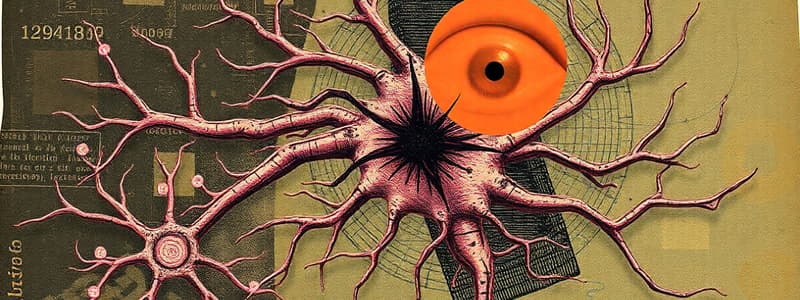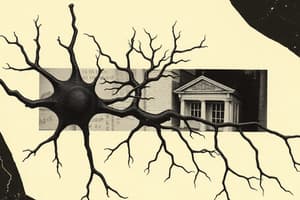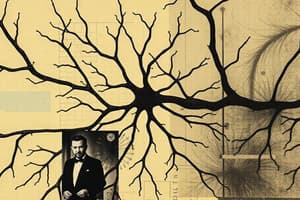Podcast
Questions and Answers
What is the primary role of microtubules in neurons?
What is the primary role of microtubules in neurons?
- They directly conduct electrical impulses.
- They provide structural support to the neuron.
- They are responsible for neurotransmitter synthesis.
- They facilitate intracellular transport. (correct)
Which part of the neuron is primarily responsible for receiving information from neighboring cells?
Which part of the neuron is primarily responsible for receiving information from neighboring cells?
- Dendrites (correct)
- Myelin sheath
- Cell body
- Axon
What occurs at the synapse?
What occurs at the synapse?
- Intracellular transport of proteins happens.
- Neurotransmitters are released to communicate with the postsynaptic neuron. (correct)
- Myelin sheath insulation is formed.
- Electrical impulses are generated within the cell body.
Where in the neuron does the axon hillock primarily function?
Where in the neuron does the axon hillock primarily function?
What is NOT a function of the myelin sheath?
What is NOT a function of the myelin sheath?
What is the fundamental purpose of metabolic energy in the context of neuronal function?
What is the fundamental purpose of metabolic energy in the context of neuronal function?
What occurs during depolarization of a neuron's membrane potential?
What occurs during depolarization of a neuron's membrane potential?
Which equation is used to determine the equilibrium potential of an ion based on its concentration gradient?
Which equation is used to determine the equilibrium potential of an ion based on its concentration gradient?
Which of the following types of neurons is primarily responsible for transmitting signals from sensory receptors to the central nervous system?
Which of the following types of neurons is primarily responsible for transmitting signals from sensory receptors to the central nervous system?
What distinguishes pseudounipolar neurons from other types of neurons?
What distinguishes pseudounipolar neurons from other types of neurons?
What is the primary role of interneurons in the central nervous system?
What is the primary role of interneurons in the central nervous system?
According to the Goldman-Hodgkin-Katz equation, what factors determine the membrane potential of a neuron?
According to the Goldman-Hodgkin-Katz equation, what factors determine the membrane potential of a neuron?
What neuronal structure is primarily responsible for receiving stimuli?
What neuronal structure is primarily responsible for receiving stimuli?
During repolarization, the membrane potential of a neuron returns to which state?
During repolarization, the membrane potential of a neuron returns to which state?
What percentage of cell body processes are typically branched in a multipolar neuron?
What percentage of cell body processes are typically branched in a multipolar neuron?
Which structure typically conveys information to the central nervous system (CNS)?
Which structure typically conveys information to the central nervous system (CNS)?
Which type of information does an axon transmit?
Which type of information does an axon transmit?
What determines the true trigger zone of a neuron?
What determines the true trigger zone of a neuron?
What occurs during hyperpolarization?
What occurs during hyperpolarization?
Which process involves the membrane potential being less negative than its resting state?
Which process involves the membrane potential being less negative than its resting state?
What is the primary function of the axon in a neuron?
What is the primary function of the axon in a neuron?
Which part of the neuron is primarily involved in receiving signals?
Which part of the neuron is primarily involved in receiving signals?
What role do dendritic spines play in neurons?
What role do dendritic spines play in neurons?
Which structure in the neuron determines if electrical signals can proceed through the axon?
Which structure in the neuron determines if electrical signals can proceed through the axon?
What happens at the presynaptic axon terminal?
What happens at the presynaptic axon terminal?
Which component of axons is involved in transporting molecules like neurotransmitters?
Which component of axons is involved in transporting molecules like neurotransmitters?
What is contained within the presynaptic axon terminal?
What is contained within the presynaptic axon terminal?
What is the initial segment of the axon called?
What is the initial segment of the axon called?
Which color typically represents inhibitory synapses in diagrams?
Which color typically represents inhibitory synapses in diagrams?
What are retrograde messengers in the context of neurons?
What are retrograde messengers in the context of neurons?
What role do motor proteins play in axonal transport?
What role do motor proteins play in axonal transport?
Which component of a motor protein is responsible for binding with microtubules?
Which component of a motor protein is responsible for binding with microtubules?
What is the energy source required for the walking mechanism of motor proteins?
What is the energy source required for the walking mechanism of motor proteins?
In which direction does the anterograde transport mechanism move?
In which direction does the anterograde transport mechanism move?
What typically happens to old membrane components in neurons?
What typically happens to old membrane components in neurons?
How do electrical signals in neurons propagate after being initiated?
How do electrical signals in neurons propagate after being initiated?
Which statement is true regarding the cytoplasmic continuity of neurons?
Which statement is true regarding the cytoplasmic continuity of neurons?
What characterizes the function of axons in neurons?
What characterizes the function of axons in neurons?
What is the primary purpose of the Na+-K+ ATPase in a neuron?
What is the primary purpose of the Na+-K+ ATPase in a neuron?
What occurs during synaptic vesicle recycling?
What occurs during synaptic vesicle recycling?
Which statement best describes the resting membrane potential in a typical neuron?
Which statement best describes the resting membrane potential in a typical neuron?
What is the role of K+ leak channels in maintaining the resting membrane potential?
What is the role of K+ leak channels in maintaining the resting membrane potential?
What triggers the migration of the varicella zoster virus from the neuron to the skin?
What triggers the migration of the varicella zoster virus from the neuron to the skin?
What effect does the permeability of the membrane to ions have on resting membrane potential?
What effect does the permeability of the membrane to ions have on resting membrane potential?
The electrical and concentration gradients for K+ ions are maintained by which of the following?
The electrical and concentration gradients for K+ ions are maintained by which of the following?
Which ions are mainly found in extracellular fluid?
Which ions are mainly found in extracellular fluid?
How does the selective permeability of the plasma membrane contribute to the resting membrane potential?
How does the selective permeability of the plasma membrane contribute to the resting membrane potential?
What happens during the equilibrium potential state for K+ ions?
What happens during the equilibrium potential state for K+ ions?
What type of molecules can freely cross the plasma membrane?
What type of molecules can freely cross the plasma membrane?
In which fluid are phosphate ions predominantly found?
In which fluid are phosphate ions predominantly found?
The condition where the extracellular fluid is set to 0 potential is referred to as what?
The condition where the extracellular fluid is set to 0 potential is referred to as what?
Which electrolyte is primarily responsible for generating the negative resting membrane potential?
Which electrolyte is primarily responsible for generating the negative resting membrane potential?
When the membrane is described as a capacitor, what is primarily being referred to?
When the membrane is described as a capacitor, what is primarily being referred to?
Which of the following ions is more concentrated inside a typical neuron?
Which of the following ions is more concentrated inside a typical neuron?
What primarily prevents the free movement of charged molecules across the plasma membrane?
What primarily prevents the free movement of charged molecules across the plasma membrane?
Flashcards
Dynamic Steady State
Dynamic Steady State
A state where a cell maintains a stable internal environment despite external changes, with unequal concentrations of ions across its membrane.
Membrane Potential (Vm)
Membrane Potential (Vm)
The difference in electrical potential between the inside and outside of a cell membrane. It is usually negative at rest.
Depolarization
Depolarization
A change in membrane potential making it less negative than the resting potential.
Repolarization
Repolarization
Signup and view all the flashcards
Hyperpolarization
Hyperpolarization
Signup and view all the flashcards
Nernst Equation
Nernst Equation
Signup and view all the flashcards
Goldman-Hodgkin-Katz (GHK) Equation
Goldman-Hodgkin-Katz (GHK) Equation
Signup and view all the flashcards
Neuron
Neuron
Signup and view all the flashcards
Cell Body (Soma)
Cell Body (Soma)
Signup and view all the flashcards
Axon
Axon
Signup and view all the flashcards
Cytoskeleton (Microtubules)
Cytoskeleton (Microtubules)
Signup and view all the flashcards
Axon Hillock
Axon Hillock
Signup and view all the flashcards
Dendrites
Dendrites
Signup and view all the flashcards
Synapse
Synapse
Signup and view all the flashcards
Cell membrane
Cell membrane
Signup and view all the flashcards
Resting membrane potential
Resting membrane potential
Signup and view all the flashcards
Membrane permeability
Membrane permeability
Signup and view all the flashcards
Electrolytes
Electrolytes
Signup and view all the flashcards
Interstitial fluid
Interstitial fluid
Signup and view all the flashcards
Intercellular fluid
Intercellular fluid
Signup and view all the flashcards
Na+-K+ ATPase
Na+-K+ ATPase
Signup and view all the flashcards
Concentration gradient
Concentration gradient
Signup and view all the flashcards
Electrical gradient
Electrical gradient
Signup and view all the flashcards
K+ leak channels
K+ leak channels
Signup and view all the flashcards
Equilibrium potential
Equilibrium potential
Signup and view all the flashcards
Electrochemical disequilibrium
Electrochemical disequilibrium
Signup and view all the flashcards
Channels
Channels
Signup and view all the flashcards
Capacitance
Capacitance
Signup and view all the flashcards
Sensory Neuron
Sensory Neuron
Signup and view all the flashcards
Motor Neuron
Motor Neuron
Signup and view all the flashcards
Dendritic Spines
Dendritic Spines
Signup and view all the flashcards
Presynaptic Axon Terminal
Presynaptic Axon Terminal
Signup and view all the flashcards
Axonal Transport
Axonal Transport
Signup and view all the flashcards
Neurotransmitters
Neurotransmitters
Signup and view all the flashcards
Neuromodulator
Neuromodulator
Signup and view all the flashcards
Neurohormone
Neurohormone
Signup and view all the flashcards
Microtubule-associated motor proteins
Microtubule-associated motor proteins
Signup and view all the flashcards
Anterograde axonal transport
Anterograde axonal transport
Signup and view all the flashcards
Retrograde axonal transport
Retrograde axonal transport
Signup and view all the flashcards
Shingles
Shingles
Signup and view all the flashcards
Fast axonal transport
Fast axonal transport
Signup and view all the flashcards
Slow axonal transport
Slow axonal transport
Signup and view all the flashcards
Axonal branching
Axonal branching
Signup and view all the flashcards
Synaptic vesicles
Synaptic vesicles
Signup and view all the flashcards
Study Notes
Nervous System - Resting Membrane Potential and Neuron
- Objectives:
- Understand the basic principles of resting membrane potential generation.
- Describe the anatomy of a typical neuron and its physiological functions.
Membrane Permeability
- Phospholipid bilayers of cell membranes are impermeable to charged molecules (e.g., Na+, K+, Cl−, Ca²⁺).
- These molecules are also insoluble in the hydrophobic membrane core.
- Large water-soluble molecules (e.g., proteins, nucleic acids, sugars) also require channels to cross the cell membrane.
- Small, uncharged, polar molecules (e.g., CO₂, O₂, NH₃, water) can freely cross the membrane, often with aquaporins.
Electrolyte Distribution
- Interstitial fluid: Major electrolytes are Na+, Cl−, and HCO₃⁻.
- Intracellular fluid: Major electrolytes are K+, HPO₄²⁻ (phosphate ion), and negatively charged proteins.
Dominant Ions
- Extracellular fluid: Dominant cation is Na⁺, and anion is Cl⁻.
- Intracellular fluid: Dominant cation is K⁺, and anions include phosphate ions and negatively charged proteins.
Electrical Properties
- Plasma membranes are ionic conductors, allowing ion currents.
- The concentration gradient dictates the direction of ion flow.
- The membrane's capacity to hold charges generates the transmembrane potential (electrical voltage difference).
Generation of Membrane Potential
- At equilibrium, the cell and solution are electrically and chemically balanced.
- The cell membrane acts as an insulator, preventing free ion movement between compartments.
- The Na+-K+ ATPase creates ionic concentration gradients (3 Na+ out, 2 K+ in).
- This creates a negative intracellular potential.
- K+ leak channels also contribute to the resting membrane potential.
K+ Leak Channels
- The plasma membrane has more K+ leak channels than Na+ leak channels.
- K+ leaks out due to the concentration gradient, with other ions following.
- The impermeability of the membrane to negatively charged ions creates a negative intracellular environment.
Equilibrium Potential
- Equilibrium potential (Eion) occurs when opposing forces (concentration and electrical gradients) balance the net ion movement.
Resting Membrane Potential
- All living cells have a resting membrane potential.
- Chemical and electrical disequilibrium exist at rest.
- The resting membrane potential is the measurement of electric charge inside versus outside the cell.
- A negative resting membrane potential is typical.
Neuron Anatomy & Functions
- Neurons are the functional units of the nervous system, responsible for transmitting and integrating information.
- Sensory neurons receive stimuli and carry signals to the central nervous system.
- Interneurons integrate information within the central nervous system.
- Motor neurons send signals from the central nervous system to muscles or glands.
- Neurons are excitable cells whose membrane potential can change.
Neuron Structure
- Cell body (soma): Contains the nucleus and organelles.
- Dendrites: Receive incoming signals.
- Axon: Transmits signals away from the cell body. -Axon hillock: Special region of the soma. -Presynaptic axon terminal: Swelling at axon's end with mitochondria and neurotransmitter.
Synapse
- Synapse: The region where an axon terminal communicates with its postsynaptic target cell.
- Neurotransmitters are released into the synaptic cleft, entering neighboring neurons.
Dendritic Spines
- Dendritic spines are specialized protrusions that increase contact points.
- Protein synthesis occurs in spines and can be transferred.
Signal Transmission and Axonal Transport
- Information is transmitted electrically (graded potentials) to axon hillock to action potentials.
- Signals are mostly unidirectional in the axon but bi-directional in the chemical synapses.
- Axonal transport involves movement of vesicles along microtubules with motor proteins.
Important Concepts
- Electrical signals are initiated and propagated unidirectionally along the axon.
- There is no cytoplasmic continuity between neurons.
Additional Notes
- The Goldman-Hodgkin-Katz (GHK) equation is used to calculate membrane potential, considering multiple ions' permeability.
- The resting membrane potential of a mammalian neuron is −70 mV.
Studying That Suits You
Use AI to generate personalized quizzes and flashcards to suit your learning preferences.


